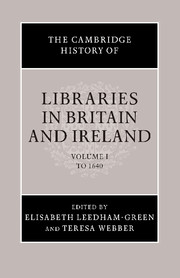Book contents
- Frontmatter
- Introduction
- The physical setting
- Part One The medieval library
- Part Two Reformation, dissolution, new learning
- Part Three Tools of the trade
- Part Four Libraries for leisure
- 21 ‘The profession of a gentleman’: books for the gentry and the nobility (c. 1560 to 1640)
- 22 Libraries of the ‘common sort’
- 23 The libraries of the antiquaries (c. 1580–1640) and the idea of a national collection
- Part Five Organisation and administration
- Select bibliography
- General index
- Index of manuscripts
- References
22 - Libraries of the ‘common sort’
from Part Four - Libraries for leisure
Published online by Cambridge University Press: 28 March 2008
- Frontmatter
- Introduction
- The physical setting
- Part One The medieval library
- Part Two Reformation, dissolution, new learning
- Part Three Tools of the trade
- Part Four Libraries for leisure
- 21 ‘The profession of a gentleman’: books for the gentry and the nobility (c. 1560 to 1640)
- 22 Libraries of the ‘common sort’
- 23 The libraries of the antiquaries (c. 1580–1640) and the idea of a national collection
- Part Five Organisation and administration
- Select bibliography
- General index
- Index of manuscripts
- References
Summary
Libraries built up by professionals – theologians, lawyers, doctors, heralds – for the purposes of their work could be, and of ten were, as we have seen, both large and valuable. The libraries for leisure built up by gentlemen and by literary figures and their patrons were likewise costly and extravagant. Where money has been expended, and where collecting has been notable, there are likely to be records, maybe in the shape of account-books or even booklists. The history of the libraries of notable men, and sometimes women, is traceable by the sixteenth and seventeenth centuries. If we turn to the possible collections of cheaper and much less beautiful print turned out for lower groups in society, but also read by their social superiors, we immediately run into difficulties.
There is a general rule which lays down that, paradoxically, the cheaper, commoner and more ephemeral an object is, the rarer are its survivals. In the wills of the ‘common sort of people’, on whom we are now focusing, books are mentioned if they were prestigious or of value. Copies of the Bible in a good binding, or of Foxe’s ‘Book of Martyrs’, might well be bequeathed in a will. Anything cheap was not likely to be found there. Similarly, the probate inventory, the list of movable goods made after a death, was highly unlikely to bother to include very inexpensive items. There was a catch-all phrase at the end of an inventory. It did not have the pejorative ring it has to us now, but an entry ‘Item, other trash’ or ‘item, other lumber’, or simply ‘for things forgot’ with a small value attached, was very often there.
- Type
- Chapter
- Information
- The Cambridge History of Libraries in Britain and Ireland , pp. 520 - 526Publisher: Cambridge University PressPrint publication year: 2006



